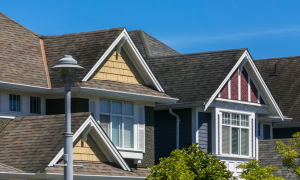By David Baur, Product Manager, GCP Applied Technologies
Spring is here! Time to get out and enjoy the great outdoors. It is also the ideal time to do a home health check-up, inspecting what winter left behind.
So, what are the three key areas of your home to examine and what do you look for? We have you covered from roof to deck. Follow this step-by-step home check-up guide to find warning signs and advice on how to repair them.
Roof: You’ve probably never thought about it, but your roof has to battle a lot of enemies: ultraviolet rays, rain, wind, snow and ice. But the good news is most new shingle roofs are designed to last about 20 years. Slate roofs and some types of tile and metal roofs can last even longer. The actual life span of your roof is determined by several factors, including environmental conditions, material quality, proper application and regular roof maintenance.
Warning Signs: How do you know when your roof is in trouble? Look for these warning signs:
Outside:
- Shingles that are warped, blistered, missing or torn
- Shingles covered in moss or algae, which hold moisture and encourage rot
- Loose material or wear around chimneys, pipes and other penetrations
- Overhanging tree branches that could gouge the roof in a strong wind
- Excessive debris (leaves, dirt, ice, roofing granules) in the gutters or downspouts, which block drainage
Inside:
- Ceiling spots or leaks
- Cracked paint
- Discolored plasterboard
- Peeling wallpaper
- Mold, mildew or rot in the walls, ceilings, insulation and electrical systems
- In the attic, look for signs of water infiltration such as staining, dampness, or mold growing on insulation/sheathing/rafters A poorly ventilated attic that shows signs of moisture, which promotes the roof’s decay. Sufficient attic ventilation can be achieved by installing larger or additional vents
Repairs Needed?
If repairs are needed, don’t skimp on quality to save a few cents. Much of the damage associated with serious storms results from water entering the home when roof coverings or siding is blown off. This is why it is imperative that you have a secondary layer of waterproofing protection underneath the shingles and siding. If proper protection measures are not taken, the resulting leaks are the main cause of interior damage, as well as potential causes of rot and mold. Rot and mold can lead to major structural damage and even potential health problems for homeowners.
Use Underlyaments: FEMA has published recommendations for the use of fully-adhered roofing underlayments, such as Grace Ice & Water Shield®, as an enhanced secondary water barrier for homes. In the event roof coverings are blown off or water manages to get underneath your shingles, these underlayments are the key to preventing water infiltration.
Windows & Doors: Beyond the roof, a home’s doors and windows can also become major leak zones. Even if the windows and doors are well shuttered in a storm, wind-driven rain can be blown into the house at these points, especially if they have not been properly flashed and weatherproofed.
Warning Signs: How do you know when your doors and windows are in trouble? The following are some signs of water damage:
Inside & Outside:
- Leaks or breaks in seams around window trim and sills
- Uneven doorframes
- Discolored plasterboard
- Peeling wallpaper
- Chipped or cracked stucco finishes
- Mold, mildew, or rot in the walls, insulation, and electrical systems
- Missing, cracked, or blistered paint inside the home
Repairs Needed?
Use Flashing: Flashing is a critical part of your home’s weather barrier system. If not properly selected and installed, wind-driven rain, ice and snow, can leak and quickly cause damage to your home. Flexible flashings such as GCP Applied Technologies’ Vycor® Plus can be used to seal the most vulnerable spots, including windows, doors, corner boards, and other non-roof detail areas. It is designed to work in severe winter climates, milder climates, and in coastal areas where wind driven rain is common.
Deck: Last but not least, check the deck.A deck is a wonderful way to enjoy the outdoors in the warmer weather. But, if your deck is not protected against the extreme weather, it can deteriorate and become unsafe. Decks, fences and other wood products should be routinely weatherproofed and cleaned to maximize their useful life. Weather combined with the treatment chemicals used for today’s pressure treated lumber means that the modern deck must be proper constructed to hold up.
Warning Signs: How do you know when your deck is in trouble? Look for these warning signs:
- Warped boards
- Cracked or split boards
- Debris that is “clogging up” space between deck boards
- Look under the deck for corroded joist hangers and other connectors
- Soft wood
- Mold and mildew
Repairs Needed?
Use a Protective Barrier: Even with today’s treated and high-tech decking products–which look great and last and last–preventing joist rot and decay, as a result of water accumulation under the decking boards, remains a major problem. Vycor Deck Protector® is a unique solution to significantly extend the useful life of decks. Vycor Deck Protector® helps prevent joist rot and decay and decrease the corrosion rate of connectors and fasteners.
By inspecting these three areas of your home and correcting any damage with the best materials, you will ensure your home will live longer. Not to mention your wallet will be happy too! Now, put on those shades and head out to enjoy the spring & summer activities with peace of mind!
David Baur is Product Manager at GCP Applied Technologies, formerly known as Grace Construction Products. He has step by step tips for homeowners, contractors and builders on building homes for extreme weather.






